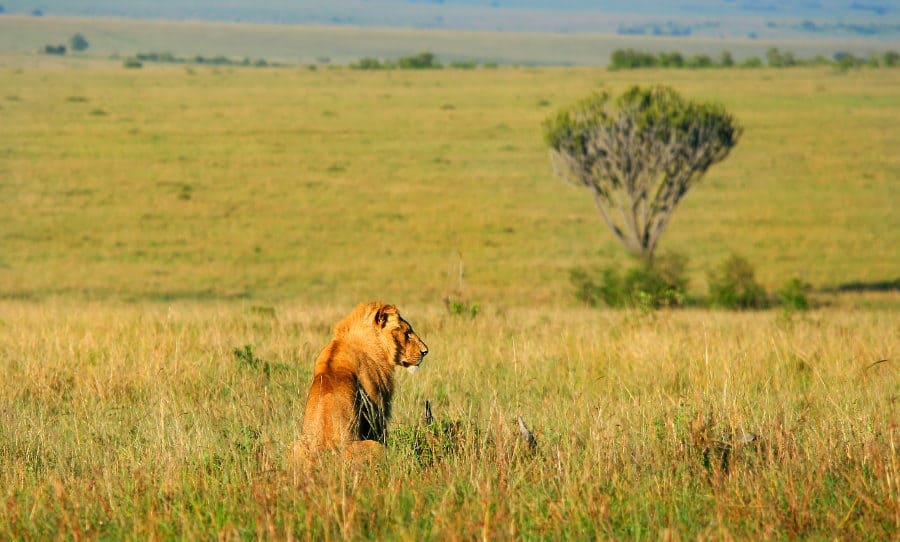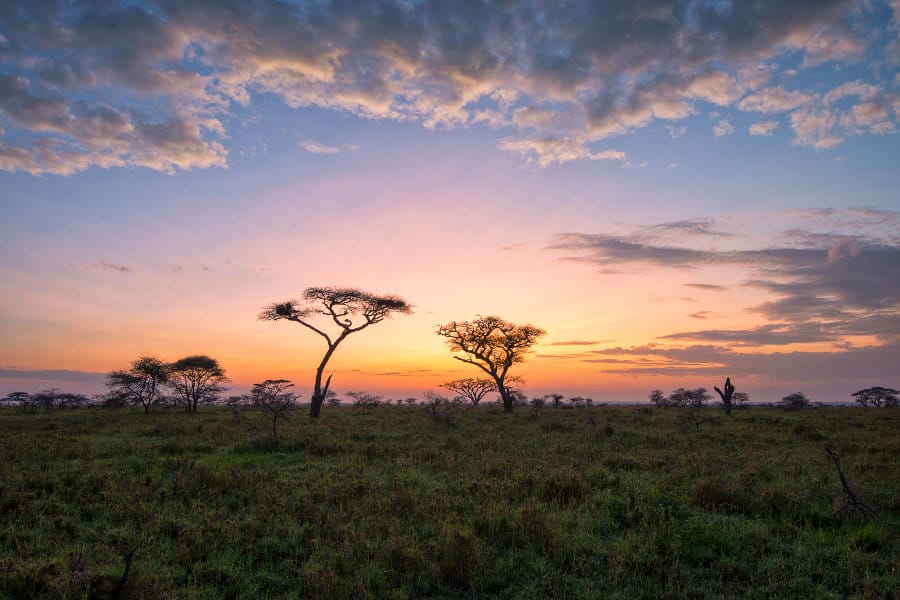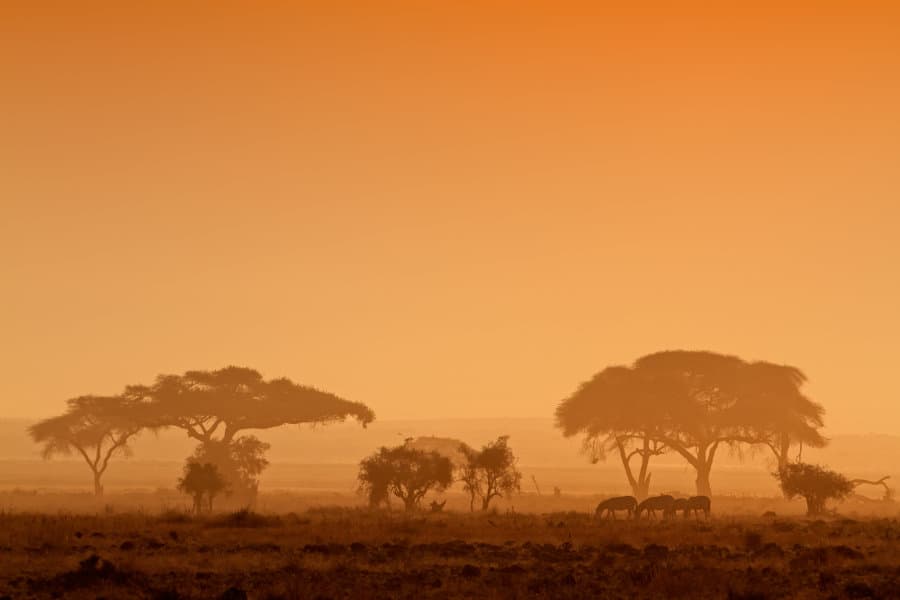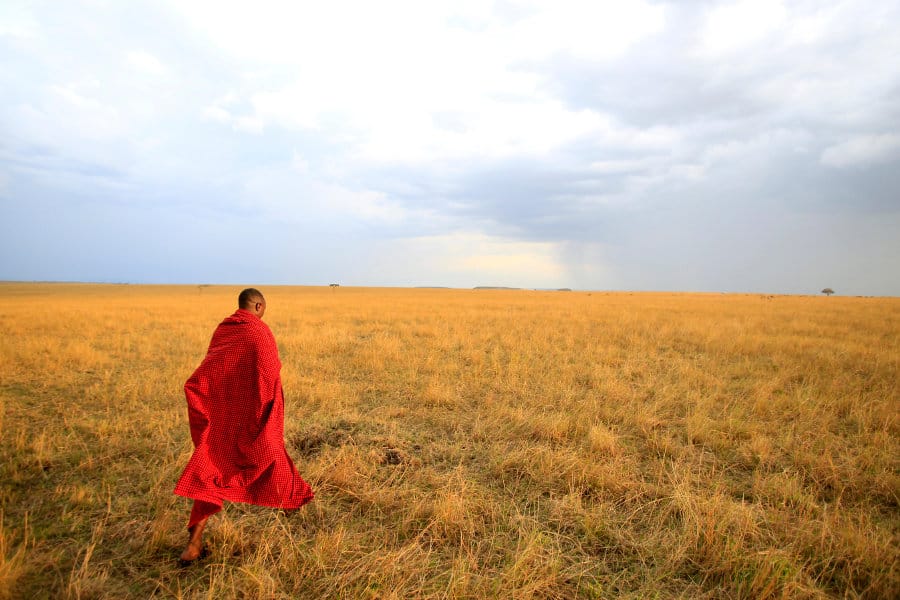The African savanna, a natural canvas for the greatest wildlife shows on earth.
Beautiful and beguiling, the savanna is where it all happens. Big cats clash with frightened herds. Four-legged giants march and migrate. Epic African safaris bring you eye to eye with savanna animals.
But what is the African savanna? Why is it so important and what makes it so special? Where can you explore the savanna and why is this landscape so different from everywhere else?
In this article we dig beneath the ochre-coloured dirt to explore the depths of the African savanna. Read on as you will discover why the savanna is integral to Africa’s incredible wildlife population, including all the animals and plants.
What is a Savanna?
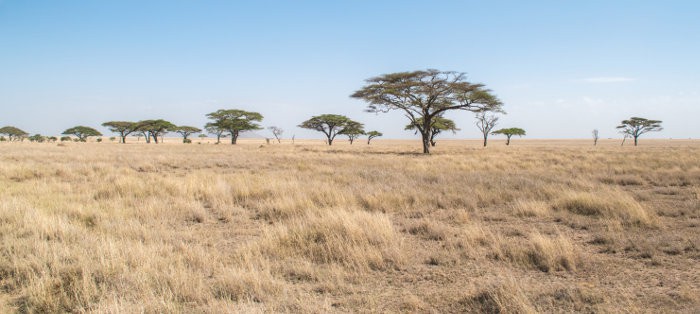
You will find savannas all over the world, not just in Africa. In fact, savanna covers one fifth of the total land on Earth. In comparison, rainforests cover less than 3%!
Can you guess where the largest savannas are located? Oh wait you already know – Africa!
A mix of grasslands and trees
A savanna is an ecosystem (or habitat) comprising of a mix of grassland and woodland. It’s a place with trees, but not enough trees to create a closed canopy.
Forests and true woodlands are defined by their canopy. Trees crisscross together and prevent light from reaching the ground. Visit a jungle or tropical rainforest and you can experience a gloomy and humid world. But the savannah is filled with light.
In some savannahs the trees are sparse. There simply isn’t enough of them to create a canopy. But because there are at least some trees, these savannahs can support a wider variety of wildlife.
Other savannas have lots of trees but these exist in small clumps. They are like a patchwork of grass and trees. That means a place for the browsers and the grazers.
Some savannas have tree coverage as high as 80%, others are as low as 5%.
Defined by a seasonal climate
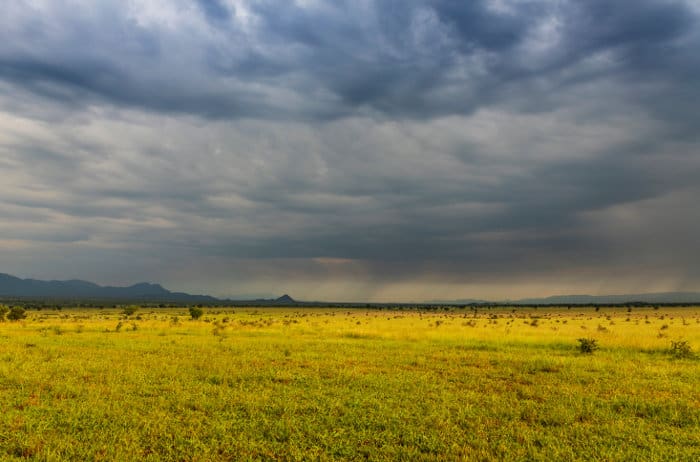
Rainforests and jungles have stable climates. They are hot, humid, and it rains virtually every day. Great rainforests like the Congo create their own rain. Precipitation is followed by evaporation and then more precipitation.
All this water is perfect for large plants like trees to grow. They soak up the daily downpour and expand!
Savannahs have an extreme climatic variation between seasons. They have a dry season and a wet season. The East African savanna is defined by two rainy seasons and two dry seasons each year.
Supporting grass and trees
Grass is the most durable plant on our planet. It can lay dormant for months, even years, then spring to life when the rains comes down.
Grass is lush and green after rain, but turns brown to conserve water during dry months. Frequent fires and grazing animals keep the grass short, so it doesn’t take over the trees.
Many different African trees have evolved to cope with changing seasons. For example, baobab trees can store up to 120,000 litres of water in their trunk, which helps them fight through the long dry seasons.
Other trees store the water in their long bulbous roots. They lose their leaves in the dry season so they can preserve water.
These trees need to send their roots far and wide so they can suck up as much water as possible. And by spreading their roots they prevent other trees from becoming near neighbours.
So it’s because of the seasonal climate that the trees are spaced around the grass, which creates a savannah.
Regulated by fires
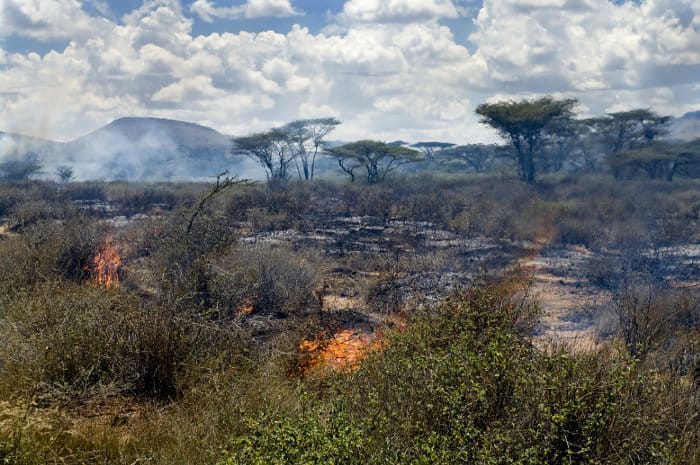
Wildfires are essential to all savannahs.
Fires cut down the grass and prevents it from taking over. They regenerate the soil by recycling nutrients, especially those stored in dead vegetation.
Most African savanna wildfires are caused by lightning strikes. Torrential wet season storms are defined by dramatic lightning. Fortunately, with all the rain the fires don’t get too wild.
Dry season wild fires cause more damage. These can also be caused by lightning strikes. Dry brown grass doesn’t hold any water and can spark alight during the hottest part of the day.
Unfortunately, people also start fires to regenerate soil. When human communities and agricultural areas encroach on wild savannah there is a chance for fires to spread from farmland to wilderness.
People also regenerate land with fires. During the dry season these fires can grow out of control and impact the wilderness. So while wildfire is essential to regulating any savannah, too much fire is not a good thing.
The African Savannah Biome

Savannahs can be found on every continent except for Antarctica. But the biggest and wildest are found at the heart of all evolution, in Africa.
Contrasts between dry and wet seasons are extreme.
For example, Serengeti National Park receives almost 300 mm of rain during March and April. But for June to August there is less than 30 mm.
The South Africa Kruger regularly goes three months without any rain, from June to August, but averages 90 mm a month from December to February.
Two factors make African savannas different from those on five other continents.
Firstly, Africa has preserved its savannas. In America an epic grassland savannah became agricultural land in less than one century. In Australia the trees were cleared for livestock and crops.
Africa is the continent where you can still find unexplored wilderness. Local tribes and communities have lived in harmony with nature. So instead of chopping down the savannah for farmland, they have conserved a natural space.
Preserve the space and you preserve a place where wildlife can thrive. And that’s what makes the African savannah really special – all the animals.
African Savanna Animals

Nowhere else in the world has more wildlife than the African savannah. Nowhere other than Africa has such an astonishing variety of life.
The savannah is unique in that it attracts grazers, browsers and carnivores.
Grazers come for the grass of course.
Browsers feed from high-growing vegetation, such as giraffe picking leaves from the highest branches and black rhinos hooking their upper lip into trees.
All the herbivores support the carnivores.
This article on African animals can give you more detailed information on the different species found across the continent. You can also follow links to discover fascinating stories and facts about African wildlife.
For now, here’s an overview of how the African savanna supports different animals.
Large land mammals
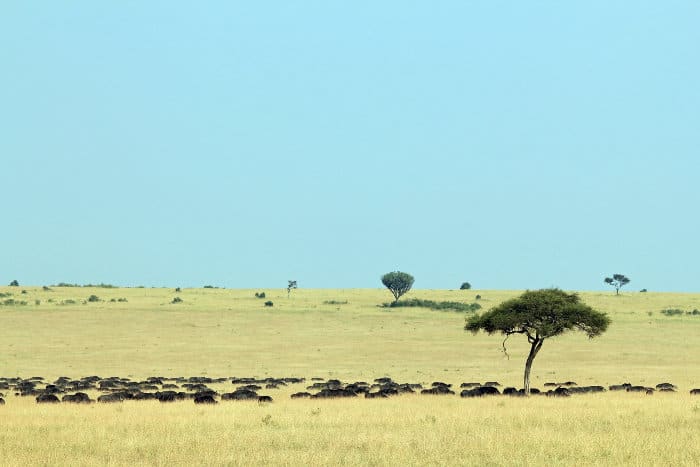
Giant mammals like elephants need lots of space. They also need an incredible quantity of food.
Did you know that elephants can eat over 250 kg of food every single day? They are the archetypal savannah animal because they consume both grass and trees. African elephants chomp through all the high grass and bash their way into trees to eat bark, twigs and foliage.
Cape buffalo and white rhinos are grazers. Giraffe are browsers. Their diets are completely different yet they can all coexist on the African savannah.
Many of Africa’s largest antelope species are browsers, including kudu, eland, nyala and steenbok. These animals are usually found in and around the trees, near their food.
Hippos are grazers. They rarely venture into the trees, preferring a daytime of watery wallowing and a nighttime of feeding on lush grass.
Large land mammals don’t really need to hide. They’re too big to conceal themselves anyway.
Their existence relies on space. A large African savannah wilderness can provide home to tens of thousands of elephants, hippos, giraffe and buffalo. But in some savannahs you can only encounter a handful of these giants.
Smaller grazing and browsing herbivores
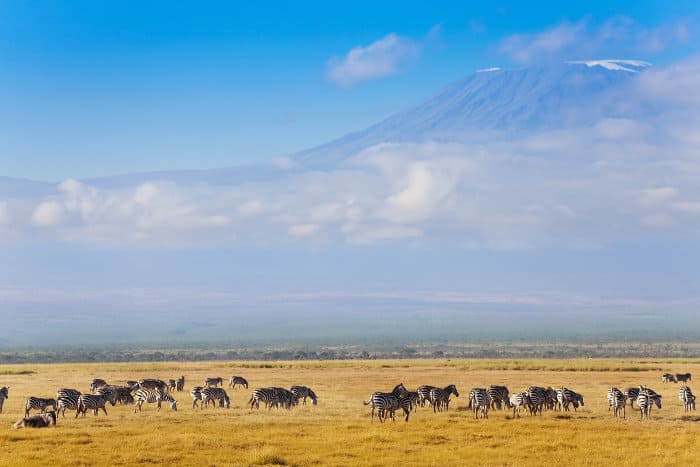
Some African savannahs are home to over 100 different mammal species. Most are home to at least 50.
That’s important to remember when you consider where to go on an African safari. The cheapest private game reserves may only have 20 different species, while the Kruger or Chobe savannah is home to more than 100.
Many of the grazers travel in herds and are continually on the move to fresher pastures. They move with the rains, with the best example of this being the great wildebeest migration.
Most of Africa’s most elegant antelope and smallest antelope are at home in the savanna. Impala are one of Africa’s most abundant species. They are a quintessential African savanna resident because they can graze and browse.
These smaller herbivores have evolved different tactics to avoid predators.
Many antelope choose to graze on big open spaces, far from tree cover, as usually the fringes between trees and grass are the most dangerous.
Some use camouflage. For example, zebra stripes prevent lions from identifying an individual target in the dark. Springbok are the same gold-brown colour as the dry season grass.
Others rely on their speed and agility. Animals like the tiny dik-dik prefer to hide. Many savanna species work together and alert each other of danger.
Primates
Almost all primates live in trees. Think of a monkey or macaque and you immediately think of a rainforest or jungle.
Humans may have chopped down and destroyed most of their forest home on Earth, but humans still have special adaptations for climbing trees. Gorillas are more terrestrial than monkeys yet they still live among the trees.
The African savanna has trees and these support an incredible array of primates, from colobus monkeys to baboons. These omnivorous animals browse the trees for fruit and leaves, but are also partial to insects and meatier meals.
Predators

Trees provide food to browsers and prove a perfect place for leopards to hide. They can conceal themselves before launching a strike. Other predators lurk in the trees, where they can enjoy shade before attacking animals on the fringes.
Lions are perfectly camouflaged with dry savannah grass. Their dusty brown coats merge into the landscape. Lions can run very fast but they can’t maintain their speed, so they must use stealth to sneak up on their quarry.
Cheetah are the fastest land mammals and they too need to get close, because their stamina only permits up to one kilometre of sprinting.
Have you noticed that lions, leopards and cheetahs are a similar colour? When the grass is low during dry season they can blend in. And when the grass is green it’s also usually high enough for these predators to hide.
Hyenas and African wild dogs don’t use camouflage. Instead they rely on stamina and space. They will chase their prey over large distances.
Predators also swoop down from the skies. Juvenile antelope cannot venture too close to the trees for threat of lions and leopards. But out in the open they are prey to some of Africa’s most impressive eagles, sometimes also vultures as well.
African Savanna Plants
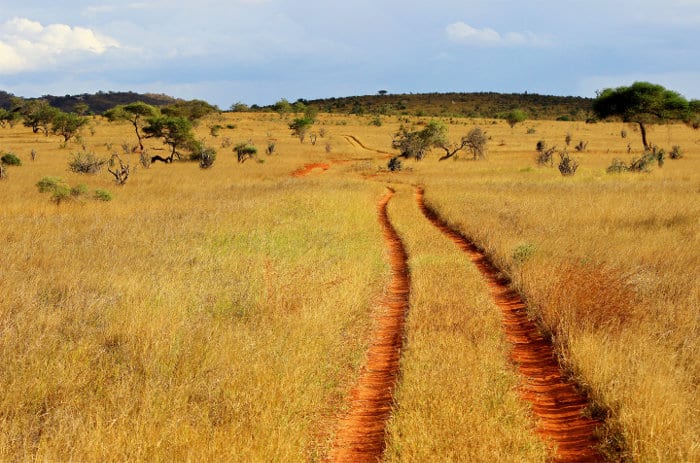
Grass
Grass, grass, endless grass. It extends forever in all directions, punctuated by the odd acacia or baobab tree.
Before discussing all the incredible African savanna trees, let’s take a moment to recognise the qualities of grass. Nothing in the world is as hardy. Grass can thrive almost anywhere.
All it needs is light, which is why you won’t find much grass in the jungle or rainforest, beneath a closed canopy.
Elephant grass can grow more than two metres high yet needs very little water or nutrients. It’s abundant in uncultivated wilderness areas where other plants can’t grow.
Cat’s tail grass doesn’t have leaves, so it doesn’t have much nutrient for grazers. Whereas common finger grass and foxtail buffalo grass is heaven for migratory herbivores.
Guinea grass is a tasty discovery for all types of grazers while nine-awned grass grows quickly in damaged soil, so it helps land recover after overgrazing or drought.
Red grass grows in clay soil, such as the ochre dirt you can find in Uganda. Antelope eat creeping bristle grass like we eat cookies – it’s tasty but low on substance.
The African savanna is home to more than 170 different grass types and many thousands of individual grass species.
So it’s not just grass, grass and endless grass. Every savanna has a different collection of grass that suits a different set of grazers.
A beautiful diversity of trees
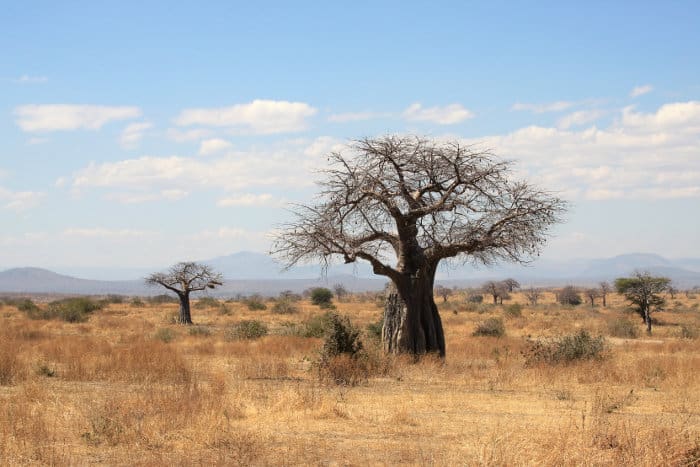
The same beautiful diversity can be seen in the trees of the African savannah. Different trees create subtly different ecosystems which impact the animal population.
Take Kruger as an example. Mopane savanna blurs into bushwillow woodland and stretches of stunted knob thorn savannah. There are thorn thickets, marula savannah, and large swathes of African savannah marked by bushes rather than trees.
In total the Kruger has 12 different African savannah ecosystems. That’s 12 in just one national park!
Baobabs are probably the most iconic of the trees. A single tree can live for thousands of years. Usually they stand alone and use their incredible root system to suck up water to be stored in their bulbous trunks. But in Tarangire National Park in Tanzania the African savannah is almost a baobab forest.
Bushwillow trees rise around rivers, where they can sink their roots into permanent water. Termites live inside jackalberry trees. The tree provides protection and the termites don’t eat their happy home, but aerate the soil with their mounds.
Spectacular candelabra trees grow upwards from a single trunk. Buffalo thorn trees stand more than 16 metres tall. Knob thorns are fire resistant.
Sausage trees are loved by many different browsers, especially for fruit that looks like giant sausages. Then there are dozens of mopane trees, perennial favourites for animals from duikers to black rhinos.
Acacias

Acacias are one of the most common savannah trees. There are hundreds of different African acacias and some can survive 11 months without water.
But check this out for 21st century colonialism. Australia has won a botanical society appeal so only Australian acacia trees can be called acacia! The first named acacia was an African scented thorn. Now all African acacias will be known by the name Senegalia. No, this isn’t a hoax!
The famous umbrella thorn acacia (oh wait, silly me, the umbrella thorn senegalia…) sends its roots 40 metres under the ground, so it can suck up water in the dry season. An umbrella shape maximises sunlight capture, while small thorns mean animals can’t eat the leaves. Except for giraffe – they’ve evolved long necks and tough tongues just for the umbrella acacia.
Whistling thorn acacia trees are especially common around the Serengeti. Stinging ants live in the fruit of these trees and deter any browsers.
When Will You Explore the African Savanna?
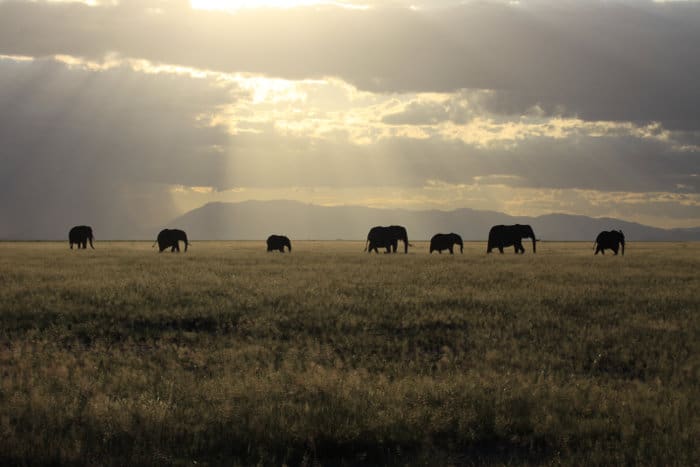
Most of the best African safaris take place on the African savanna.
Some destinations like the Okavango and Etosha are not savanna. But the vast majority are, so if you visit Africa you can discover all the beautiful flora and animals living on the savanna.
This ultimate guide to African safari is a good place to start. Or take a look around the site to find your own favourite African animal.
